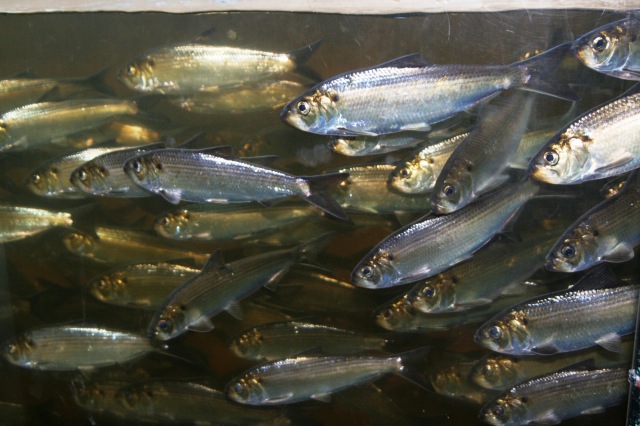Listen to this short audio clip about invasive species in the Great Lakes region of N. America. You’ll hear several different animals being described. The questions are going to ask you to match the animals to the given descriptions. Listen carefully, and remember that the questions might use synonyms and rephrasing for what you actually hear in the clip.
If the audio player doesn’t work for you, please try the clip on Audioboom.
The Great Lakes are home to a number of invasive species. Which feature is related to the different animals?
Features
- A: arrive in water
- B: come attached to the bottom of boats
- C: harm ecosystems
- D: were brought to America to help fish farmers
- E: are physically prevented from entering the Great Lakes
- F: control the numbers of alewives
- G: are declining in number
- H: are growing in number
Choose eight features from the above list and write the correct letter A-H next to questions 1-8.
- pacific salmon
- indigenous fish
- zebra muscles
- Asian carp
- alewives
- sea lampreys
- a lot of invasive species.
- non-native fish from the Mississippi River
Answers are below the image of a sea lamprey
- F
- H
- B
- D
- G
- C
- A
- E
The Great Lakes Today: Invasive Species
Scientists estimate that there are more than 170 invasive species in the Great Lakes today. These are non-native plants and animals that invade a new ecosystem. The sea lamprey that I described earlier is one such invader.
Most Invaders arrive by sea. Most invasive species travel to the Great Lakes by water; some come in from the ballast water of ships. Ballast water is water pumped into the bottom of the ship to keep it stable. When the ship arrives at port it releases the water; it also releases any creatures in the water.
Other invaders such as the zebra mussel hitch rides on the bottom of ships. Once zebra mussels reach a place, they multiply madly; up to seventy thousand mussels can thrive in a single square metre of water.
Invasive species upset the ecosystem. Invaders like the zebra mussels, sea lamprey and alewife have all damaged the Great Lakes ecosystem. Zebra mussels, for example, steal food from native species; they clog water pipes; they attach to docks and make swimming dangerous because of their sharp shells.
The Asian carp is another great threat to the Great Lakes. Catfish farmers in the south of America brought this fish from Asia to clean their ponds. Some carp have escaped into rivers and have migrated to Lake Michigan. Many people fear the Great Lakes will someday become giant carp ponds.
Canada and the United States are working to prevent non-natives from entering the Lakes. Shippers are being asked to treat their ballast water more carefully. A barrier has been built to keep fish in the Mississippi River from entering the The Great Lakes. Several states have banned the sale of live Asian carp for fear that would destroy the Great Lakes food chain.
Another approach has been to stock the lakes with species that will eat the invaders. Pacific salmon have been introduced to the Great Lakes to control alewives. Alewife numbers have dropped greatly as a result and native fish have begun to recover.



Not so easy. But the audio is clear and I can get half of them. Good practice. Thanks
The answers are not correct ! I think the answers are :
1.F
2.H
3.B
4.D
5.G
6.C
7.A
8.E
Thanks for that. You are 100% correct. I recently added a couple of extra questions into the list and I seem to have messed up the order. It’s fixed now and I’ve transcribed the recording to make it easier to see the answers.